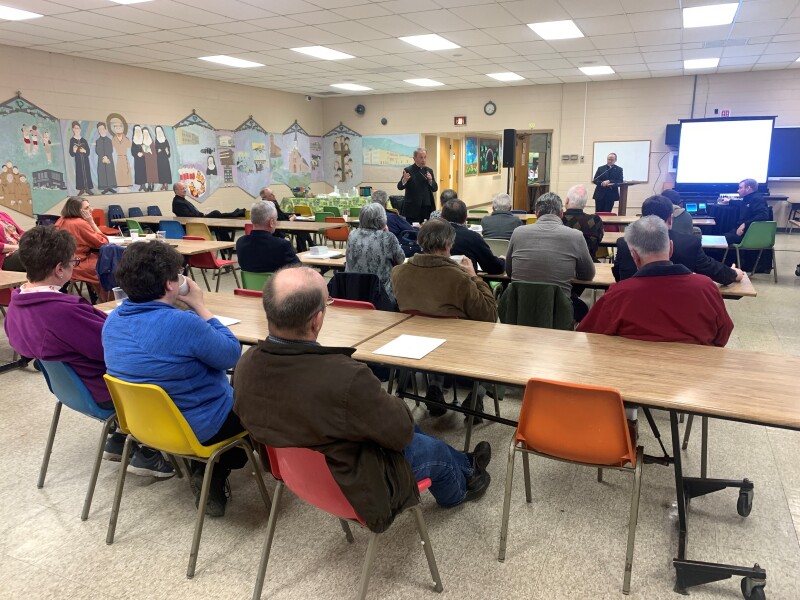
DIOCESE INITIATES ANOTHER ROUND OF PARISH RESTRUCTURING
Anne-Marie Welsh
03/20/2023

meeting discussing the need for pastoral planning. Photo/Anne-Marie Welsh
NORTHWEST PA — Calling it the most important comment he is making during his presentations at deaneries around the diocese, Erie Bishop Lawrence Persico has been opening his remarks with the following: “We are, always have been and always will be a missionary church. We are called not only to care for those who attend Mass, but also to invite others into the community Christ established on earth.”
The bishop is meeting with pastors and a handful of staff and volunteers from parishes in a number of deaneries this spring. (There are currently ten deaneries in the diocese. See a map here.) Several of the meetings are follow-ups to presentations that were made last fall; others are initial meetings including the presentation of statistics and other data pertinent to various regions.
Meetings have been held for the Bradford and Clearfield deaneries; another is scheduled for the Oil City Deanery by the end of this week. Later this month, an initial meeting will be held for pastors and parish leaders in Erie County.
The bishop is emphasizing that the goal “is to create parish communities that are vibrant, life-giving places of worship and places where people find encouragement and hope as they grow in their relationship with Christ, his church and each other.” He is noting his gratitude that the steps are being taken in the midst of the national Eucharistic Revival.
“I trust the additional graces and prayers and growth will strengthen us for the next steps on our journey as a diocese,” he says.
Bishop Persico is well-aware of the challenges of more change.
“The idea of restructuring brings up many emotions,” he says. “Our churches are beautiful and we love them. We are comfortable in the parish communities many of us have known our entire lives. But the realities we are facing continue to strain our resources.”
Msgr. Edward Lohse, vicar general of the Diocese of Erie, is accompanying the bishop at the meetings, presenting important statistics to help parishioners understand the current state of affairs. Among them:
- The overall population in the 13 counties of the Diocese of Erie has dropped by approximately seven percent since 1990.
- Attendance at Mass during the same timeframe has dropped by approximately 78 percent. While this has been accelerated by the COVID-19 pandemic, attendance had dropped from 120,000 people in 1990 to 52,113 by 2012. Just prior to the pandemic, in 2019, attendance was as 36,927. This year, it is 26, 770.
- Restructuring has been ongoing throughout the history of the diocese, sometimes one parish at a time, sometimes through a more widespread effort. In 1990, there were 127 parishes. In 2012 there were 117. Today there are 93.
- The number of clergy in the diocese is another factor. In 1990 there were 210 active priests serving in the diocese; that number dropped to 130 by 2012 and today stands at 92. It is likely that number will be 62 by 2031.
Despite the significant work that has already been accomplished through pastoral planning, Msgr. Lohse says “We unfortunately are in the situation of examining what we can do and what we need to do, not necessarily what we might like to do.”
The process will be similar to the restructuring that occurred in 2016-2017.
“While hard decisions had to be made,” Bishop Persico says, “it was a synodal experience of our own. By that I mean it involved engaging discussions at many levels and in the end, every parishioner who wanted to comment on the situation or to propose a particular change, was given the opportunity to do so. In several instances, parishioners offered insights that were extremely helpful in shaping the final plan.”
Parish leaders in each area of the diocese who have been approached so far made recommendations to Bishop Persico based on data and projections presented by Meitler Consultants, whose work was made possible by a grant from the Catholic Foundation of Northwest Pennsylvania. Those recommendations were used to create the preliminary plans now being presented. Parish leaders will now bring the proposed plan to their parish communities and decide if and how it should be refined. Individual parishioners all will have the opportunity to weigh in through an online survey.
“Each generation has different challenges and needs to make adjustments in response to its situation,” Bishop Persico says. “It should not surprise us that sacrifice will be involved as we continue listening to the Holy Spirit and responding to the call of missionary discipleship and evangelization.” He also notes that it is our turn to think about those who will come after us.
“What needs to happen so that future generations of Catholics can not only survive but thrive within loving communities of worship?” he asks.
The Diocese of Erie is the largest diocese, geographically, in the commonwealth of Pennsylvania.
"Our geography includes everything from mid-sized and small urban cities connected by four-lane highways to very small hamlets accessible only by two-lane country roads,” he says. “In some areas, it is possible to walk between churches. In others, there may be 30 miles between churches. Decisions about the future need to be made with the big picture in mind. What needs to happen in order to care for all of the people in our diocese?”
On March 24, the diocese will launch a micro-site devoted to pastoral planning with several important resources, including a pastoral letter from Bishop Persico. The letter will be made available in a series of shorter publications parishes can share in bulletins and online.
-
